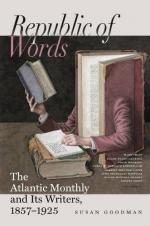was born, to the end of the century. In these
thirty-five years, the stout walls and the tall tower
of the Bargello were built, the grand foundations
of the Palazzo Vecchio and of the unrivalled Duomo
were laid, and both in one year; the Baptistery—
Il
mio bel San Giovanni—was adorned with
a new covering of marble; the churches of Sta Maria
Novella, of Or San Michele, (changed from its original
object,) and Sta Croce,—the finest churches
even now in Florence,—were all begun and
carried far on to completion. Each new work was
at once the fruit and the seed of glorious energy.
The small city, of less than one hundred thousand
inhabitants, the little republic, not so large as
Rhode Island or Delaware, was setting an example which
later and bigger and richer republics have not followed.[6]
It might well, indeed, be called a “new life”
for Florence, as well as for Dante. When it was
determined to supply the place of the old church of
Santa Reparata with a new cathedral, a decree was
passed in words of memorable spirit: “Whereas
it is the highest interest of a people of illustrious
origin so to proceed in its affairs that men may perceive
from its external works that its doings are at once
wise and magnanimous, it is therefore ordered, that
Arnolfo, architect of our commune, prepare the model
or design for the rebuilding of Santa Reparata, with
such supreme and lavish magnificence that neither
the industry nor the capacity of man shall be able
to devise anything more grand or more beautiful; inasmuch
as the most judicious in this city have pronounced
the opinion, in public and private conferences, that
no work of the commune should be undertaken, unless
the design be to make it correspondent with a heart
which is of the greatest nature, because composed
of the spirit of many citizens united together in
one single will."[7] The records of few other cities
contain a decree so magnificent as this.
It would be strange, indeed, if the youthful book
of one so sensitive to external influences as Dante
did not give evidence of sympathy with such pervading
emotion. And so apparent is this,—that
one may say that only at such a period, when strength
of sentiment was finding vent in all manner of free
expression, was such a book possible. Confidence,
frankness, directness in the rendering of personal
feeling are rare, except in conditions of society
when the emotional spirit is stronger than the critical.
The secret of the active power of the arts at this
time was the conscious or unconscious resort of those
who practised them to the springs of Nature, from
which the streams of all true Art proceed. Dante
was the first of the moderns to seek Poetry at the
same fountain, and to free her from the chains of
conventionality which had long bound her. In
this he shows his close relation to his times.
It is his fidelity to Nature which has made him a
leader for all successive generations. The “Vita
Nuova” was the beginning of a new school of
poetry and of prose as completely as Giotto’s
O was the beginning of a new school of painting.




